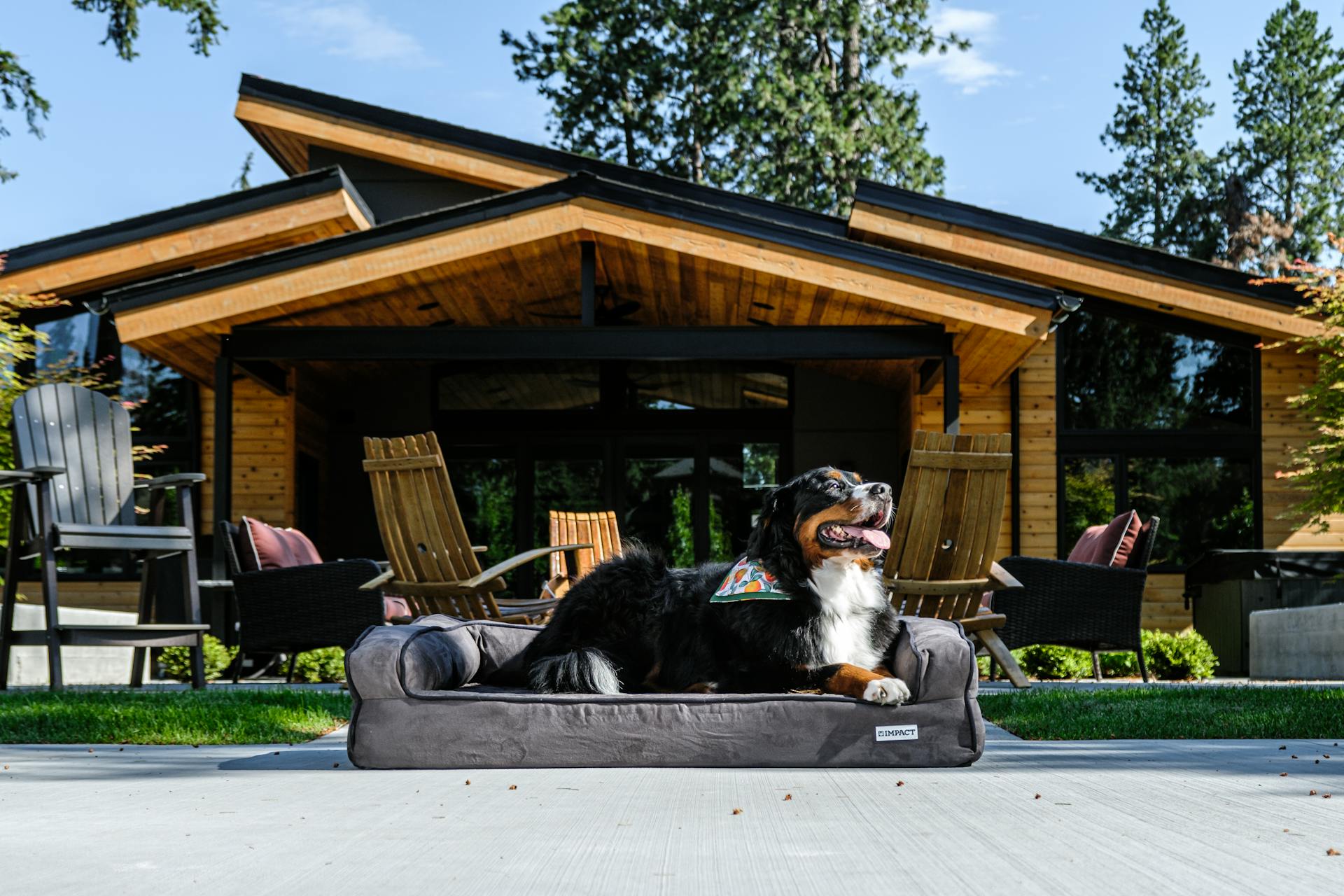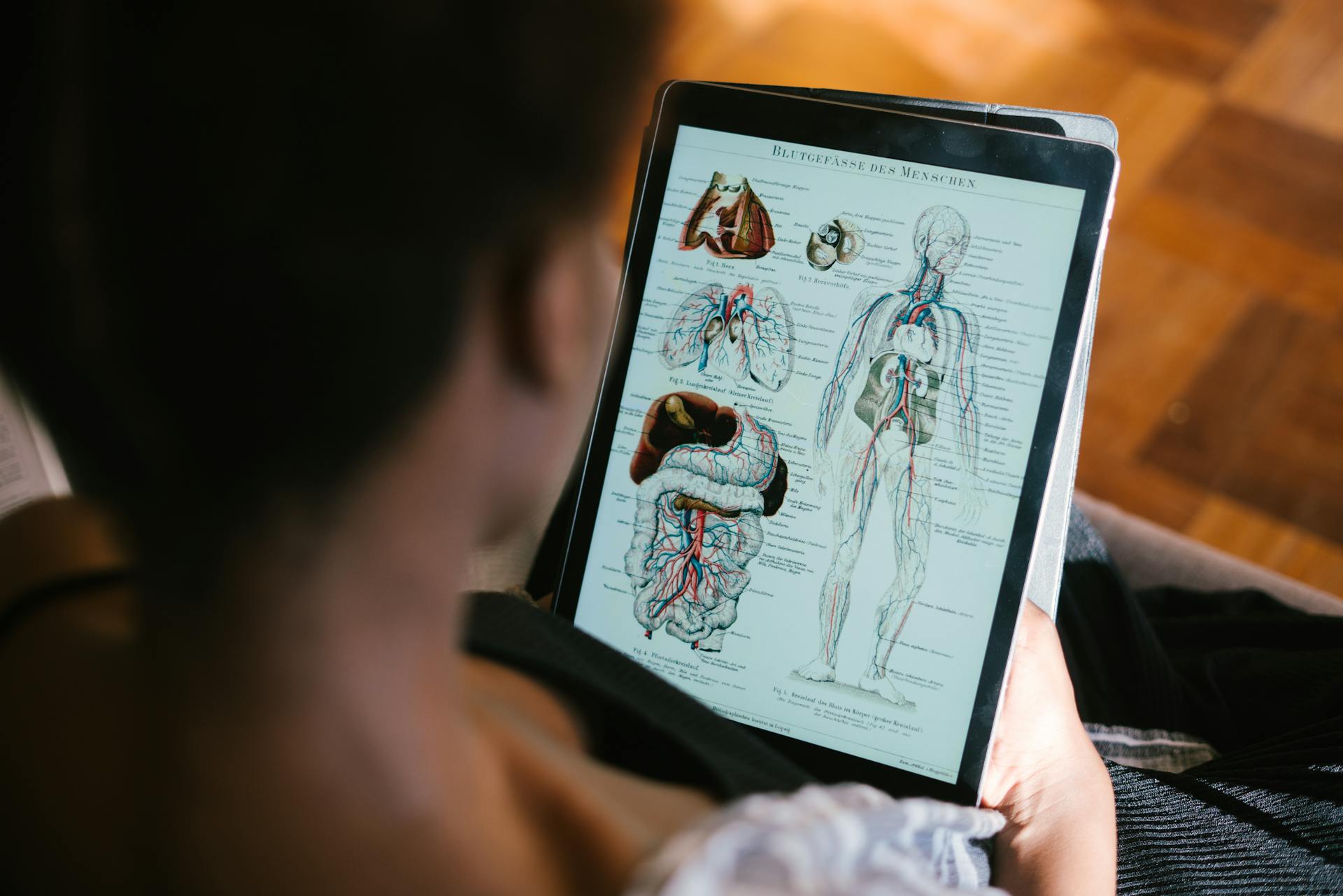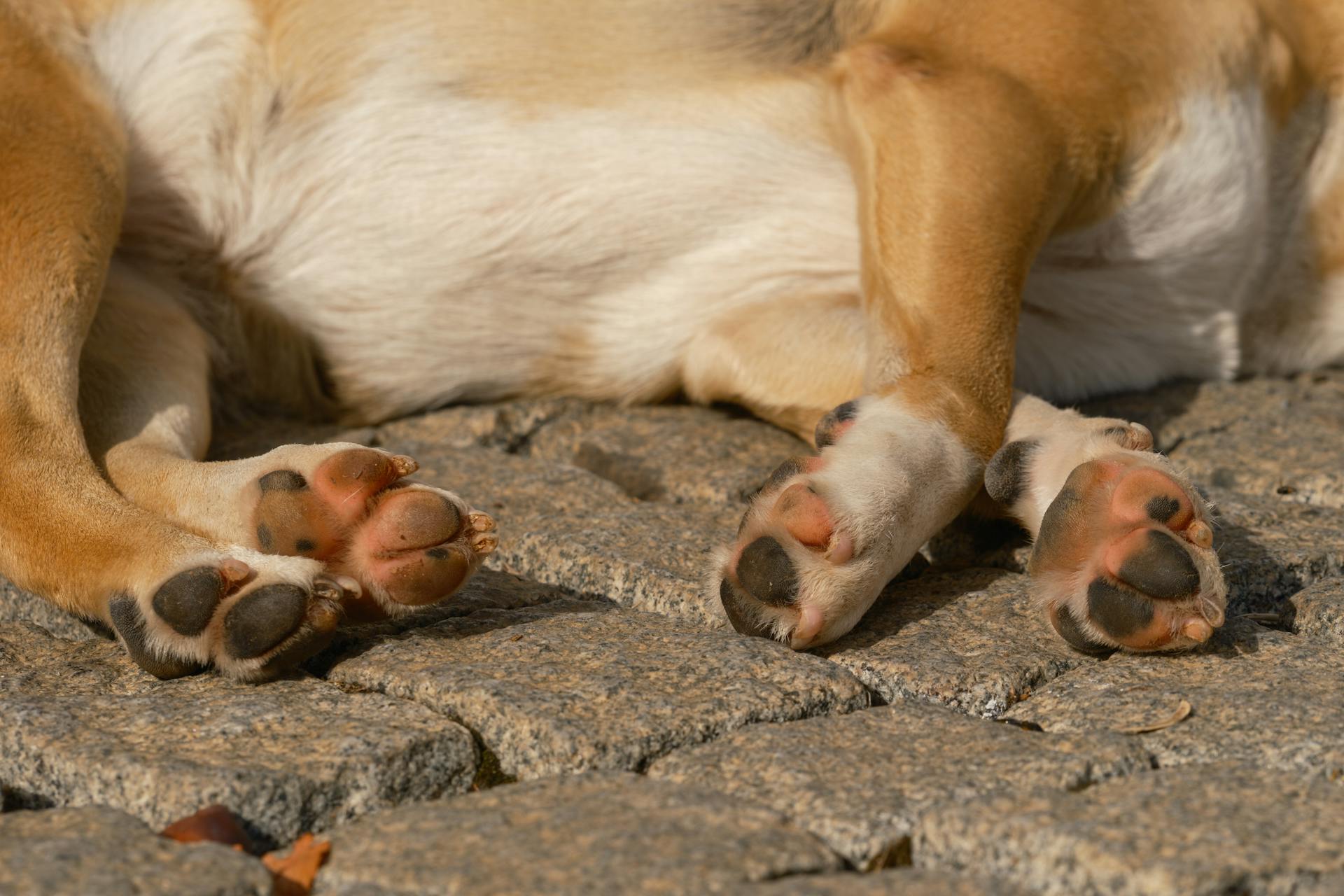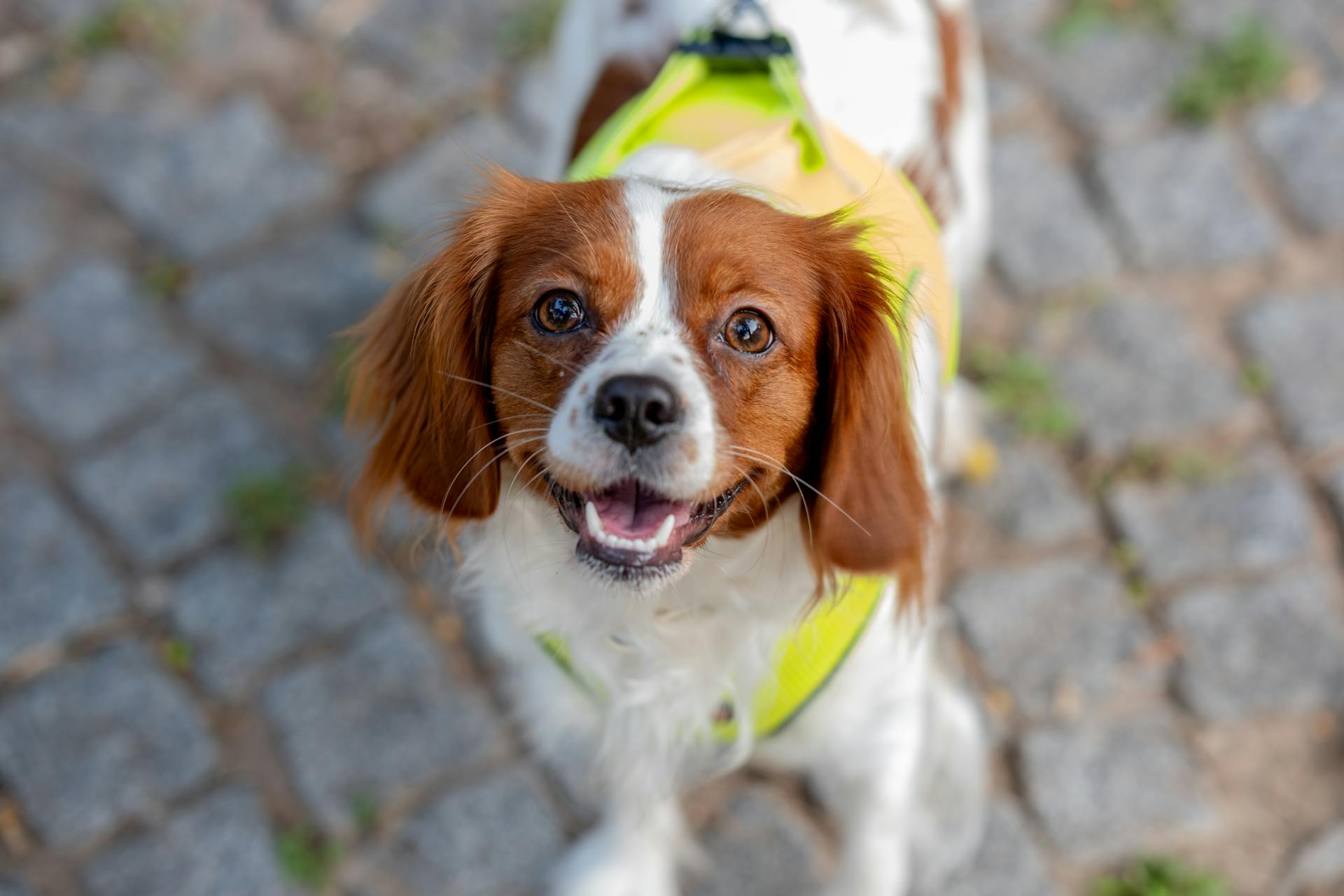
Understanding canine elbow anatomy is crucial for any dog owner or enthusiast. The elbow joint, also known as the humeroulnar joint, is a complex structure that allows for a wide range of motion.
It's made up of three bones: the humerus, radius, and ulna. The humerus is the long bone of the upper arm, while the radius and ulna are the two bones of the forearm.
Dogs have a unique elbow anatomy that sets them apart from humans. Unlike humans, dogs have a more flexible elbow joint that allows for greater mobility.
This flexibility is due in part to the unique anatomy of the radius and ulna bones, which are connected by a special joint called the radioulnar joint.
Canine Elbow Anatomy
The canine elbow anatomy is a complex and fascinating system. It's formed by the humeral condyle, the head of the radius, and the trochlear notch of the ulnar bones, which together form the humeroradial and humeroulnar joints.
The dog elbow joint is a composite joint that allows for a range of movement, specifically extension and flexion movements, with a range of 100-140 degrees in the sagittal plane. This range may vary depending on the breed of dog.
The elbow joint is connected to the radioulnar joint, and the distal extremity of the humerus articulates with the proximal extremity of the radius and ulna bones. This connection is crucial for the proper functioning of the elbow joint.
Here's a summary of the key bones involved in the canine elbow anatomy:
- Humerus
- Radius
- Ulna
These bones work together to allow the dog to move its elbow joint in a hinge-like motion, which is essential for everyday activities like walking and running.
Joint Anatomy
The canine elbow joint is a composite joint formed by the humeroradial and humeroulnar joints, which are connected to the radioulnar joint. This joint is crucial for the dog's movement and flexibility.
The elbow joint is made up of three bones: the humerus, radius, and ulna. The humerus is the longest bone in the dog's arm, and it's directed obliquely downward and backward from the scapula to the proximal part of the radius and ulna bone. The humerus has a long body and two distinct extremities: the proximal and distal ends.
The humerus's proximal extremity has a well-developed, rounded, and more convex head, a prominent greater tubercle (lateral), and a less developed medial or lesser tubercle. The intertuberal groove, several small foramina, and a constricted small neck are also present in the proximal extremity.
The body of the humerus has four surfaces, with the deltoid tuberosity being the most prominent osteological feature on the lateral surface. The brachial groove is also present on the lateral surface, although it's not as spiral as in other animals. The tuberosity of the teres major is found on the medial surface, while the humeral crest is less developed on the cranial surface.
The caudal surface of the humerus begins at the neck and extends to the distal third of the bone, which continues with the lateral supracondylar crest. This surface is smooth, convex, and possesses a prominent nutrient foramen.
The elbow joint has a capsule enclosing the joint, which is strong and fibrous, strengthening the joint. The joint capsule is thickened medially and laterally to form collateral ligaments, which stabilize the flexing and extending motion of the arm.
Here are the different types of joints found in the dog elbow:
- Humeroradial joint
- Humeroulnar joint
- Radioulnar joint
The elbow joint also has several bursae, including the intratendinous olecranon, subtendinous olecranon, and subcutaneous olecranon bursa. These bursae reduce friction between tendons, bone, and skin during movement.
Prevention
Keeping your puppy trim as they grow is crucial, especially if they're prone to orthopedic defects. You don't want to scrimp on essential nutrients, but a chubby puppy can lead to joint problems.
Your veterinarian may recommend joint supplements from a young age, even for normal pups. They'll also encourage moderate exercise to prevent overgrowth.
Jumping down from high places can lead to front leg problems, such as "jump down" injuries. This can be caused by repetitive movements like jumping off the bed or stairs.
Going down long flights of stairs frequently can add trauma to your puppy's joints. Breeders recommend avoiding more than 2 or 3 stairs until 6 months of age or older.
Rigorous screenings for breeding animals can help decrease cases of elbow dysplasia. A registry system to reduce the number of dysplastic puppies produced would be the most effective strategy.
Detecting pain and lameness early is key to preventing further damage. Performing an arthroscopic coronoidectomy, followed by intensive non-surgical supportive care, can help alleviate symptoms.
Consider reading: How Do You Work Out Dog Years
Causes and Symptoms
Canine elbow anatomy is a complex system, and understanding its causes and symptoms is crucial for proper diagnosis and treatment.
Unhappy elbows, also known as medial epicondylitis, can be caused by repetitive strain on the medial epicondyle, a bony prominence on the inside of the elbow joint.
This strain can occur from activities that involve heavy pulling, such as swimming or hunting, which is why some breeds are more prone to this condition.
The symptoms of unhappy elbows can include pain, swelling, and stiffness in the elbow joint, often accompanied by a limp or reluctance to jump.
In severe cases, the condition can lead to arthritis and chronic pain, making it essential to seek veterinary care early on.
The medial epicondyle is a critical part of the canine elbow anatomy, and its improper development can contribute to the development of unhappy elbows.
Curious to learn more? Check out: Lupus in German Shepherds
Diagnosis and Treatment
Diagnosis of elbow dysplasia typically occurs between 4 to 12 months of age, although some dogs may not show lameness until 7 or 8 years of age.
A thorough lameness exam and radiographs, including flexed views of both elbows, are crucial for diagnosing elbow dysplasia. CT scans and arthroscopic surgery may also be used to guide diagnosis and therapy.
Early intervention is key, and surgery can significantly reduce a dog's pain. In mild cases, surgery aims to remove damaged tissues and relieve pain, while moderate-to-severe cases may require extensive surgery to realign the malformed elbow joint.
The goal of treatment is to slow the progression of arthritis and prolong the patient's use of the elbow. Surgical elbow replacement is a new option, but it comes with serious complications and is still being developed.
A physical examination and radiographs are essential for diagnosing elbow dysplasia. In some cases, additional tests like CT scans may be required to detect joint problems at an early stage.
Diagnosis
Diagnosis usually occurs between 4 to 12 months of age, when a thorough lameness evaluation and physical examination are performed.

Most dogs are diagnosed with elbow dysplasia by physical examination and thorough lameness evaluation.
True elbow dysplasia won't be diagnosed before 4 to 6 months of age, when growth plates in joints are still closing.
In mild cases, affected dogs may not show lameness until 7 or 8 years of age, when arthritis kicks in.
A physical examination is very useful in localizing the cause of lameness, and by observing your dog move and palpating the limb(s), the veterinarian can isolate the specific bone or joint responsible.
Radiographs (x-rays) may show if any bone fragments are present within the joint and whether or not arthritis has developed.
Treatment
Early intervention is key when it comes to treating elbow dysplasia in dogs. Surgery can significantly reduce pain and lameness, with a success rate of about 85% of cases showing improvement.
The goal of surgery is to remove damaged tissues and slow the progression of arthritis. This can be done through arthroscopic surgery, where the damaged tissues are removed through small openings in the joint.

For more severe cases, extensive surgery may be necessary to realign the malformed elbow joint. This can involve cutting the ulna and repairing it with stainless steel pins and wire.
Even after surgery, some dogs may still experience lameness and need to be restricted from heavy exercise. In these cases, follow-up rehabilitation is critical to ensure the best possible outcome.
If your dog is a candidate for surgical elbow replacement, it's essential to ensure their weight is ideal and that their other joints are in great shape. This is a complex and expensive procedure, and it's crucial to carefully weigh the risks and benefits.
In some cases, medical treatment may be the best option for older arthritic joints. This can include pain relievers, joint lubricating drugs, physical therapy, acupuncture, stem cell therapy, and anti-inflammatory medications.
Specific Conditions
Canine elbow anatomy is complex, but understanding specific conditions can help you better care for your dog's joint health.
Ununited anconeal process (UAP) is a condition where the anconeal process, a small bone in the elbow joint, fails to fuse properly, leading to arthritis and mobility issues.
This condition can cause pain and stiffness in the elbow, making it difficult for your dog to run or jump.
In some cases, UAP can be caused by genetics, while in others, it may be the result of an injury or infection.
Dysplasia
Dysplasia is a condition where cells in a part of the body don't mature properly. This can happen in various parts of the body, including the bone marrow, skin, and organs.
Dysplasia can be a precursor to cancer, as abnormal cell growth can eventually develop into cancerous tumors. In the case of bone marrow dysplasia, it can lead to conditions like anemia and infections.
The symptoms of dysplasia can vary depending on the affected area, but they often include pain, fatigue, and difficulty healing. For example, skin dysplasia can cause lesions or growths that are difficult to treat.
Dysplasia can be caused by a combination of genetic and environmental factors, including radiation exposure and certain chemicals. In some cases, it can be a result of a genetic disorder.
While there is no cure for dysplasia, treatment options are available to manage symptoms and prevent complications. In some cases, surgery may be necessary to remove affected tissue.
Medial Coronoid Process Fragmentation
Medial Coronoid Process Fragmentation is a common issue that can cause discomfort and pain in the elbow joint. It occurs when a fragment of the medial coronoid process breaks off and becomes loose in the joint.
This condition often arises from repetitive stress and overuse, such as in athletes who participate in sports that involve throwing or repetitive elbow extension. The medial coronoid process is a small bony prominence on the humerus that plays a crucial role in elbow joint stability.
Symptoms of medial coronoid process fragmentation may include elbow pain, stiffness, and limited range of motion. In some cases, the pain may radiate down the forearm or into the hand.
Treatment options for medial coronoid process fragmentation typically involve conservative measures such as physical therapy and bracing, although in severe cases, surgery may be necessary to remove the loose fragment and repair any damaged tissue.
Medial Compartment Disease (MCD)
Medial Compartment Disease (MCD) is a specific manifestation of elbow pathologies, specifically affecting the medial compartment of the elbow.
A diagnosis of MCD requires an arthroscopic assessment of the elbow with surgical confirmation of joint abnormalities that are restricted to the medial compartment.
In MCD elbows, the disease involvement of the lateral compartment is minimal or non-existent.
Treatment strategies for MCD may differ from those for elbows with involvement of both the medial and lateral compartments.
MCD elbows may require specialized treatment approaches that take into account the unique characteristics of this condition.
Explore further: Canine Leishmaniasis Treatment
Frequently Asked Questions
What are the 4 types of elbow dysplasia in dogs?
Elbow dysplasia in dogs is comprised of two main categories: medial compartment disease (including FCP, OCD, joint incongruity, and cartilage anomaly) and UAP. The four specific types of medial compartment disease are FCP, OCD, joint incongruity, and cartilage anomaly.
What are the three joints in a dog's elbow?
A dog's elbow is made up of three joint compartments: the humero-ulnar, humero-radial, and proximal radio-ulnar joint. These joints are formed by the humerus, radius, and ulna bones.
Sources
- https://anatomylearner.com/dog-elbow-anatomy/
- https://www.vet.cornell.edu/departments-centers-and-institutes/riney-canine-health-center/canine-health-information/elbow-dysplasia
- https://www.semanticscholar.org/paper/Magnetic-resonance-imaging-of-the-canine-elbow%3A-an-Baeumlin-Rycke/088cedb5564103841c3b0cf5917473ff89d9997c
- https://teachmeanatomy.info/upper-limb/joints/elbow-joint/
- http://www.vscdsurgerycenters.com/procedures-techniques/elbow-dysplasia/
Featured Images: pexels.com


